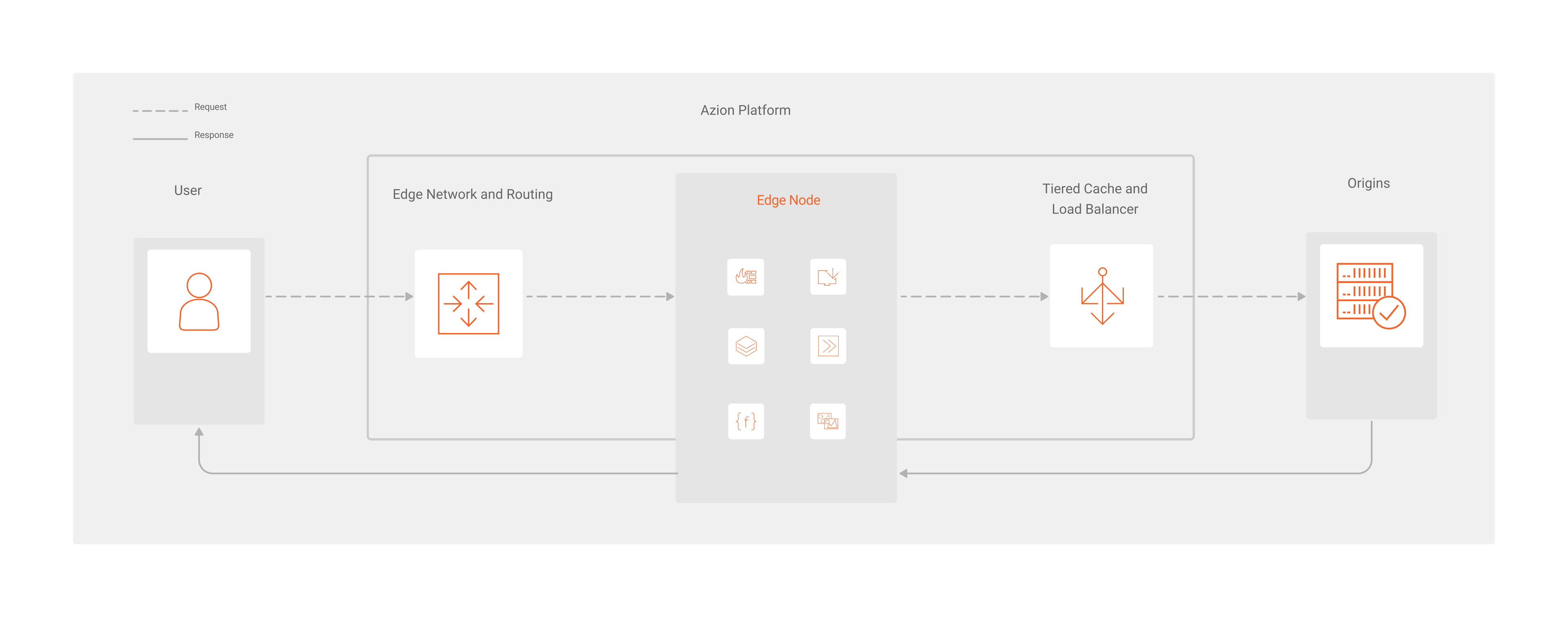Azion platform overview
Azion Web Platform allows you to deploy your projects instantly on the most reliable global network, leverage enterprise-grade security, and scale from zero to peak without cold starts.
Azion is the leading web platform enabling businesses to build, secure, and scale modern applications on a fully-managed global infrastructure. With a robust suite of solutions for Application Development, cybersecurity, and AI, Azion empowers developers and enterprises to deliver high-performance and secure digital experiences worldwide. Trusted by global leaders such as Prime Video, Neon, Global Fashion Group, and Radware, Azion provides the fastest path to modern applications. Discover how Azion can transform your digital experiences at www.azion.com.
Core Concepts
What’s edge computing?
Edge computing is a highly distributed computing paradigm that aims to bring computation and data storage closer to the location where it’s needed, typically near the “edge” of the network. It enables the building and management of modern applications able to meet the growing demand for real-time processing, reduced latency, improved data privacy, and the ability to handle the massive amount of data generated nowadays.
What’s an edge-native platform?
Following edge computing principles, an edge-native platform must be designed to operate efficiently at the edge of a network. For this reason, the platform should possess several key characteristics and functionalities to meet the unique challenges and requirements of edge computing:
- Seamless experience for application development, security, orchestration, and observability.
- NoOps and self-service approach.
- Open standards.
- Continuous monitoring and observability.
- Performance optimization tools to optimize resource allocation and application performance.
- Geographical coverage and traffic optimization strategies.
How Azion Web Platform attends a request
Azion Web Platform is built over a robust infrastructure composed of various key components, as well as business logic and rules that allow for offering a reliable, scalable, and high-performance service.
Taking advantage of its distributed network and decentralized infrastructure, it quickly serves the requests with low latency and less bandwidth consumption, optimizing the content delivery and enhancing user experience.
Azion’s platform works, on a high level, this way:

- A request is sent to a web service running on the Azion Web Platform and it defines, using software-define routing, the best path to the request and redirects it to the closest edge location.
- In this context, closer refers to the edge node that can serve the user request the fastest, based on a variety of factors such as geographic location, network conditions, server load, among others.
- Inside the edge node, the request is processed by multiple functional modules before sending back an appropriate response to the user. This involves applying all the adequate business logic, configurations, and parameters to the request. Through the Azion products, customers can implement, control, monitor, scale, and automate resources at the edge, in real time.
- The request is redirected to the origin just in case the edge node doesn’t have an appropriate response.
- The response is sent to the user or device.
What to do with Azion?
Azion provides different products and modules based on edge computing technology, grouped into main categories that reflect each step in the process of building and managing edge applications:
This includes tasks such as:
- Building and deploying edge applications that run directly at the edge of the network.
- Using templates and integrations to speed up your deployment and test pre-built solutions.
- Creating zero trust architectures to protect your content and applications.
- Improving your content delivery by relying on a highly distributed network.
- Defining caching rules, custom optimizations, and advanced configurations.
- Monitoring your applications with data in real time.
- Improving your performance, with lower latency and bandwidth usage, while reducing operational costs.
- Developing with different supported frameworks and languages.
- Migrating your architecture and content to the edge.
- Observe compliance laws.
Platform management
Azion has developed a control panel and a set of APIs used by customers and the Azion team to manage the Azion Web Platform. It runs on the edge and leverages a microservices architecture and a proprietary front-end framework, ensuring security and high availability.
You can access it and get a simple and fast user experience through:
- Azion Console: it’s the configuration interface. With Console, you have access to all the products and services provided by Azion, being able to create and manage them. Azion Console also enables the management of provisioning, accounting, billing, and user permissions.
- Azion CLI: it’s an open source tool that enables the management of services using a terminal. The Azion CLI is built in Go.
- Azion API: it’s a RESTful API based on HTTPS requests. It allows you to integrate your systems with Azion’s platform and create new applications and services, as well as checking, removing, or updating existing settings.
- Azion Terraform Provider: Terraform communicates with the Azion APIs, so you can manage your infrastructure hosted on the Azion’s platform, locally, as code.